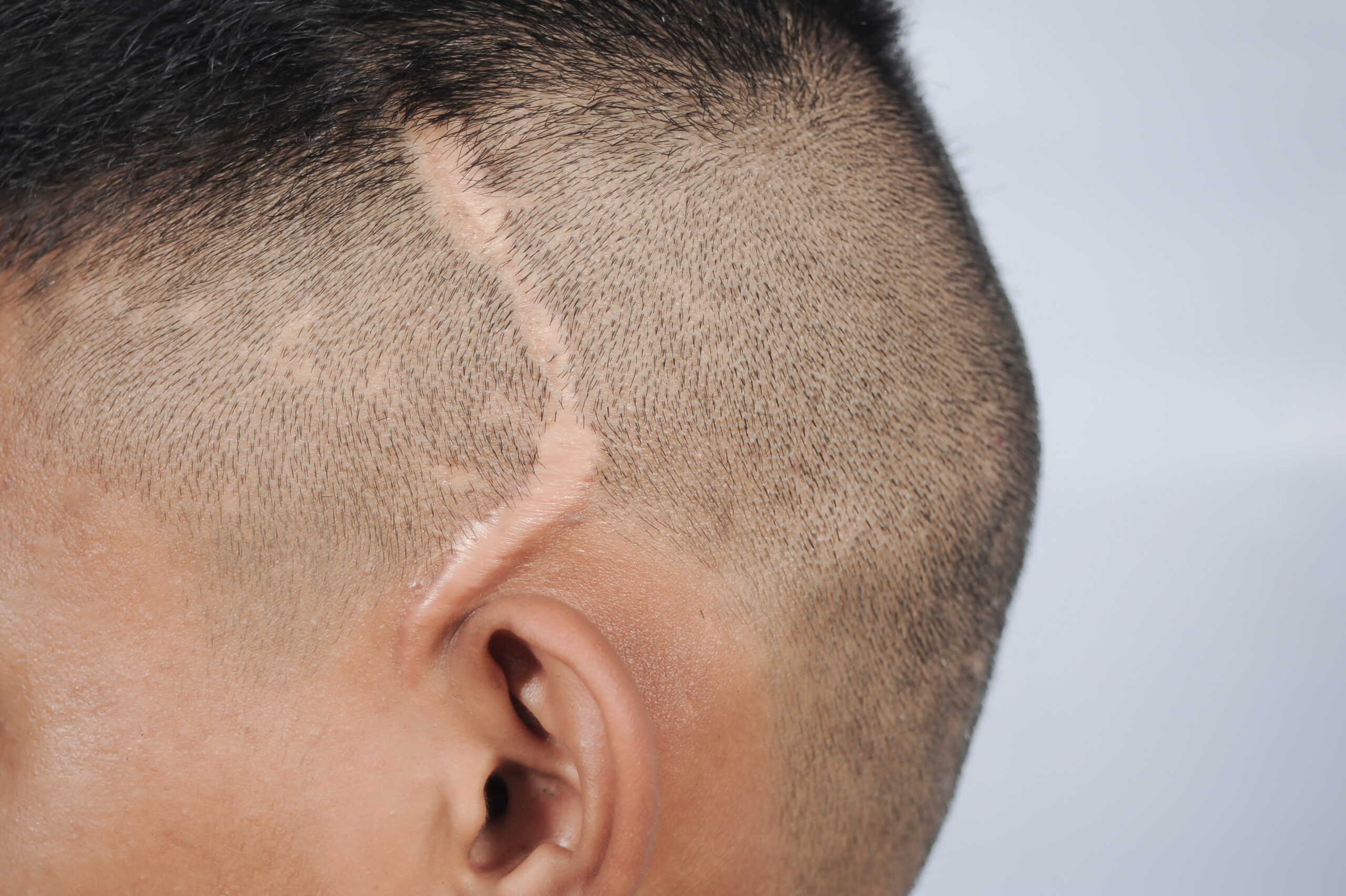On average, over 100 million patients develop scars across the industrialized world each year. Various problems can cause these scars, such as a medical procedure or surgery. There are 55 million elective surgeries and 25 million medical operations after trauma-related accidents. Some of these procedures can cause sizeable problems, which often lead to scarring and/or disfigurement that can last a lifetime.
Too many times, traumatic injuries result in lasting injuries, like scarring and disfigurement. Whether the cause is an automobile accident, heavy machinery accident, dog bite, burn, or amputation, visible scarring and disfigurement can be mortifying and, in some cases, can change a person’s life forever. It can cheat them out of particular jobs and their overall quality of life, such as the loss of friends or potential partners.
What is Scarring and Disfigurement?
Undergoing any type of injury can cause instantaneous, physical damage that can be brutal, but many people don’t think of the long-lasting complications these traumatic injuries leave. Many patients who suffer traumatic injuries are left with permanent blemishes–scars and disfigurements– that provide a physical reminder of their situation's trauma and emotional harm.
Scars
Scars are a natural part of the body’s healing process and result from the biological function of wound repair within the skin and surrounding tissues. Scars form when the dermis, a deep, thick layer of the skin, is damaged. Aside from minor scars, most scars result in some extent of scarring.
Scars result from the skin being opened and wounded due to an accident or surgical operation. They may take place following an injury from an automobile accident, animal attack, or other severe accident; however, they may also arise from a rather uneventful injury, such as a minor cut or scrape.
Scars may look thick and red in color, but the majority will fade and heal over time. Many factors influence the way a scar will eventually look, like the type, location, size, and severity of the injury, the way the injury was treated, and genetic factors. There are three different types of scars, consisting of:
- Keloid Scars: These scars usually result from an overly aggressive healing process. They go well past the original injury and, over time, can obstruct movement. Treatments for keloid scars can include steroid injections, surgery to remove the scar, or the injection of silicone sheets to flatten the scar. Smaller keloids can be treated using less invasive methods, such as cryotherapy (a therapy that freezes the scar using liquid nitrogen). To prevent keloids from forming, you can use pressure treatment or gel pads with silicone directly following your injury. Keloid scars tend to be more common among individuals with darker skin.
- Contracture Scars: A contracture scar often forms after the skin has been burned. These scars tighten the skin, hindering your ability to move. These scars also go deeper than the surface, sometimes even affecting the muscles and nerves.
- Hypertrophic Scars: These raised, red scars are similar to keloids but do not grow beyond the border of the injury. Treatments include steroid injections to reduce the inflammation of the scar or silicone sheet injections to flatten the scar.
The look of a fully healed scar can be enhanced by surgical procedures, dermabrasion, laser treatment, topical treatments, radiotherapy, microdermabrasion, microneedling, and other treatments. However, a scar will never mirror the appearance of the skin before the injury took place. For many people, scars are a reminder of a painful time in their lives and can significantly change their quality of life if the scar is on a noticeable part of the body like the face, chest, or extremities.
Disfigurement
Disfigurement is the state of a person’s appearance that is deeply and persistently harmed medically by either a birth defect, disease, or wound. For example, a burn, scar, skin texture, missing body limb, or an abnormally-shaped body part can affect a person’s appearance. Disfigurement can lead to negative body images, constant concern about other people's reactions to the disfigurement, difficulties in one's social, sexual, and professional lives, depression, and other serious issues.
Numerous accidents, including automobile accidents, heavy machinery accidents, animal attacks, amputation, burns, etc., can all lead to a person becoming disfigured. Acts of violence, such as assault, can also lead to disfigurement. Along with the injury that caused the initial disfigurement, which is traumatic enough, the physical reminder of your trauma can create added emotional and mental stress that sometimes leads to depression or suicidal thoughts.
Cosmetic surgeries, such as plastic or reconstructive surgery, can sometimes help a person reduce the look of the disfigurement. Although surgery can fix the disfigurement altogether, that is not always the case. Additionally, these surgeries are very expensive and, a lot of the time, are extremely risky. Being able to recover financial compensation after an injury can go a long way towards fully and healthily recovering from that injury and any lasting physical complications that may come along with it.
Types of Accidents That Cause Scars & Disfigurement
Most accidents can lead to scarring of any part of the body. Some of the most common causes consist of:
- Fires: Fires oftentimes lead to burns, the most common type of fire-related injury. When the body becomes exposed to extreme heat, tissue damage occurs, often leading to serious scarring and disfigurement. There are four degrees of severity used to identify burns:
- First-degree: the mildest type of burn that only affects the top layer of the skin. Usually heals within a few days of the burn.
- Second-degree: this burn damages a deeper layer of skin. Typically, second-degree burns will blister the skin, become very painful, and may take up to a few weeks to heal.
- Third-degree: third-degree burns damage all layers of skin. Sometimes, these burns do not feel as painful because of the damage to underlying nerves. These burns do not heal without medical treatment and usually require surgery and skin grafts.
- Fourth-degree: the most severe type of burn a person can face. These burns functionally destroy each layer of skin, causing damage to muscles, bones, and nerves. They can be life-threatening and often require amputation and multiple reconstructive surgeries.
- Defective Products: When a defective product, such as a defective vehicle, airplane, medical device, workplace product, etc., are faulty, it can cause severe damage. These products can malfunction and cause lacerations, loss of limbs, and other life-threatening injuries that often leave life-long scarring and disfigurement.
- Explosions: The burns that are caused by explosions can be very serious, leading to permanent and sometimes life-threatening scarring and disfigurements. Explosions can also lead to first, second, third, and fourth-degree burns. Some of the most common explosion burns are due to:
- Natural gas explosions
- Improperly stored chemicals
- Electronic cigarette explosions
- Defective phone batteries
- Medical Malpractice: When a victim suffers an injury as a result of the negligence of a medical professional or surgical error that was preventable, severe scarring and disfigurement can take place. Medical malpractice can lead to unnecessary limb loss, life-threatening injuries, and permanent scarring and disfigurement.
- Falls: Falls from high surfaces, rough terrain, or dangerous conditions can be disastrous. They can cause severe puncture wounds or even the loss of a limb when an object pierces someone after falling to a lower level.
- Animal attacks, including dog bites: Attacks from animals such as cats, dogs, snakes, horses, cows, and other pets, can result in permanent scars from puncture wounds, scratches, and lacerations.
- Being hit by an object on someone else’s property: When a victim is on another person’s property, and there are no proper warning signs of possible dangers, they can become severely injured. When hit with a large or sharp object, the victim can suffer minor to severe lacerations and puncture wounds, leading to irreversible scarring and disfigurement.
- Being exposed to hazardous chemicals/toxins: When in close contact with skin, hazardous chemicals and toxins can cause severe burns as a result of their highly corrosive nature. These burns can also be first, second, third, or fourth-degree burns and usually result in noticeable scarring and disfigurement.
- Construction accidents: Construction accidents happen often and result in minor to severe injuries. Falling objects, falls from high surfaces, caught between accidents, fires and explosions, electrical accidents, and defective equipment are all types of construction accidents that can result in burns, lacerations, and limb loss. Burns can range from first-degree to fourth-degree, causing severe scarring and disfigurement. Lacerations and limb loss can cause severe scarring and disfigurement as well.
- Heavy machinery/equipment accidents: Heavy machinery and equipment accidents can be detrimental or even sometimes fatal. Because of the size and weight of heavy machinery, it can result in limb loss or severe lacerations to the operator or those within close range of the machine. Too often, heavy machinery and equipment injury victims are left with lasting scarring and disfigurement.
- Automobile Accidents (motorcycle, truck, car, etc.): Automobile accidents can cause severe lacerations and cuts from shattered glass, airbag explosions, etc. Scars can be from the initial injury or result from the extensive healing process these accidents cause, such as surgery scars.
All of the accidents above can cause a victim both physical and emotional damage. Many of the injuries that these victims face will result in long-term care, whether that be multiple surgeries, continued therapy (both mental and physical), or a combination of both.
Liability and Damages
Like many other personal injury lawsuits, a plaintiff trying to recover damages from scarring and disfigurement that were the result of an accident caused by another person or party must establish four elements by a prevalence of the evidence:
- Duty: A duty arises when it is legally understood that a relationship between the defendant and the plaintiff exists, requiring the defendant to act in a particular manner, typically with a standard of care, toward the plaintiff. A judge will determine whether the defendant owed a duty of care to the plaintiff and most times will find that a duty does exist if a reasonable person would find that a duty exists under similar circumstances.
- Breach of duty: It is not enough to prove that another person owed you a duty. An injury lawyer must also be able to prove that the negligent party breached their duty to the plaintiff. A defendant breaches their duty by failing to exercise reasonable care when performing the duty. Unlike the question of if a duty exists, the issue of whether a defendant breached a duty of care is decided by a jury.
- Causation: Causation requires that the plaintiff show that the defendant’s negligence was the sole cause of their injury. There is no question that someone can act negligently, but the plaintiff must show that negligence was the only cause of the injury. This element also looks at if the defendant could have reasonably foreseen that their actions would have caused an injury. If the defendant’s actions caused the plaintiff’s injury through an unexpected act of nature, the injury will most likely not be considered unforeseeable. Meaning the defendant will not likely be found responsible.
- Damages: The final element is “damages.” This requires that the court be able to compensate the plaintiff for their injury through economic and sometimes non-economic compensation.
Both noneconomic and economic damages are available for scarring and disfigurement victims. The economic portion of damages usually includes medical bills, loss of income, and future loss of income.
Noneconomic damages are usually composed of pain and suffering and mental anguish. These damages will vary depending on what a juror believes is a natural reaction to the standard and location of the scarring or disfigurement that a victim has undergone.
The value of a scar or disfigurement will be different for each victim. Each insurance company and its adjusters often see the value of a victim's scar or disfigurement much different than the victim. However, there are some factors that are always considered when deciding what the value of a scar or disfigurement is, including:
- The age of the injured victim
- If the scar or disfigurement is permanent
- The gender and marital status of the victim
- Where the scar or disfigurement is located
- The color, size, and visibility
If you can prove that your scarring and disfigurement were due to the negligence of another party, that party can most likely be held liable for any damage you have suffered as well as future corrective damages you may face.
Scarring and Disfigurement Damages Allowed
If you are injured in a way that leads to permanent scarring and disfigurement because of another party’s negligence, you will most likely be able to make a claim for damages. You could possibly be entitled to:
- Medical costs associated with treatment. These costs can include bills from:
- Doctors that have treated underlying problems
- Plastic surgeons who performed reconstructive surgeries
- Psychologists and psychiatrists who helped the victim with their emotional damage
- Compensation for pain and suffering
- Lost earnings from days you were not able to work or from future loss of wages
The monetary figure of the damage will depend on:
- Which body part was affected
- How deep, long, and severe the wound was
- The change in the victim’s quality of life
Scarring and disfigurement can substantially change a person's life. The treatments they will need are pricey, may need to be repeated, and have the possibility of not resulting in any significant improvement. Even with care from top-rated medical professionals, scarring and disfigurement victims can still suffer permanent changes to their appearance.
Sometimes a disfigured victim may need counseling/therapy for their emotional distress, mental anguish, and pain and suffering. Scarring and disfigurement are severe and lasting injuries that sometimes allow an automobile accident victim to seek both non-economic damages and economic damages through their own no-fault benefits.
The settlement of a scar or disfigurement case will vary depending on the characteristics of the accident victim. For example, insurance companies and jurors often treat a young lady with a facial scar differently than someone who suffers scarring on their abdomen. It is assumed that young women will undergo more stress due to their altered appearance. Furthermore, the face can be harder to treat because the tissues and muscles are more complicated in this part of the body. In addition, an accident victim whose career depends on her appearance, such as a model or actress, can most times recover a more significant amount of noneconomic damages than a more timid, elderly, or male accident victim.
If you have suffered a scar or disfigurement, it is essential to ensure that your doctor has documented it in your medical records and has recorded if there is a permanent or remaining effect. It is also crucial for your doctor to note if it has caused you to lose mobility in the affected area. These medical records will support your claim to the defendant’s insurance company or the jury for the compensation you are pursuing. The more documented evidence you have against the negligent party, the better your chances are to collect the compensation you deserve.


